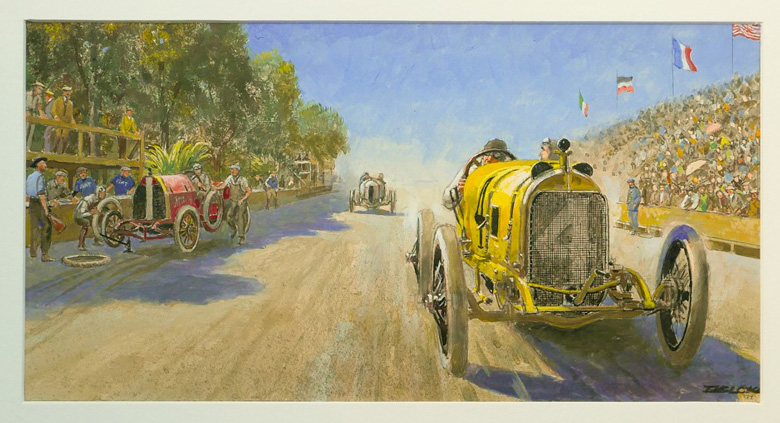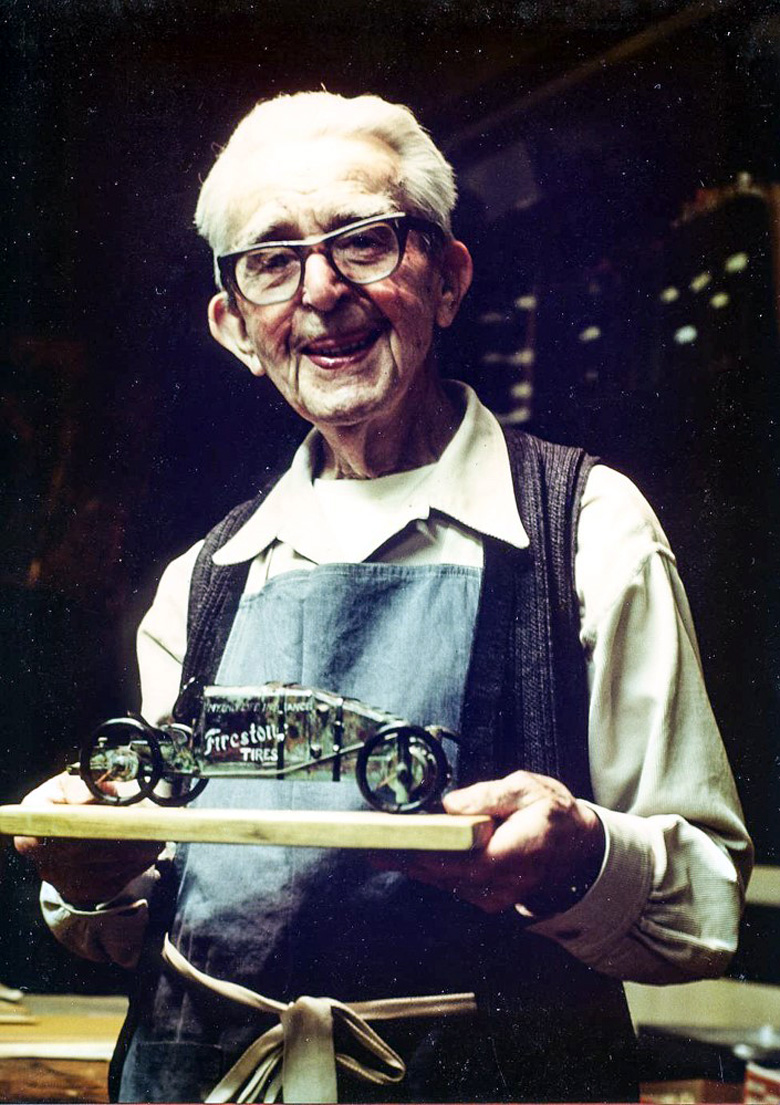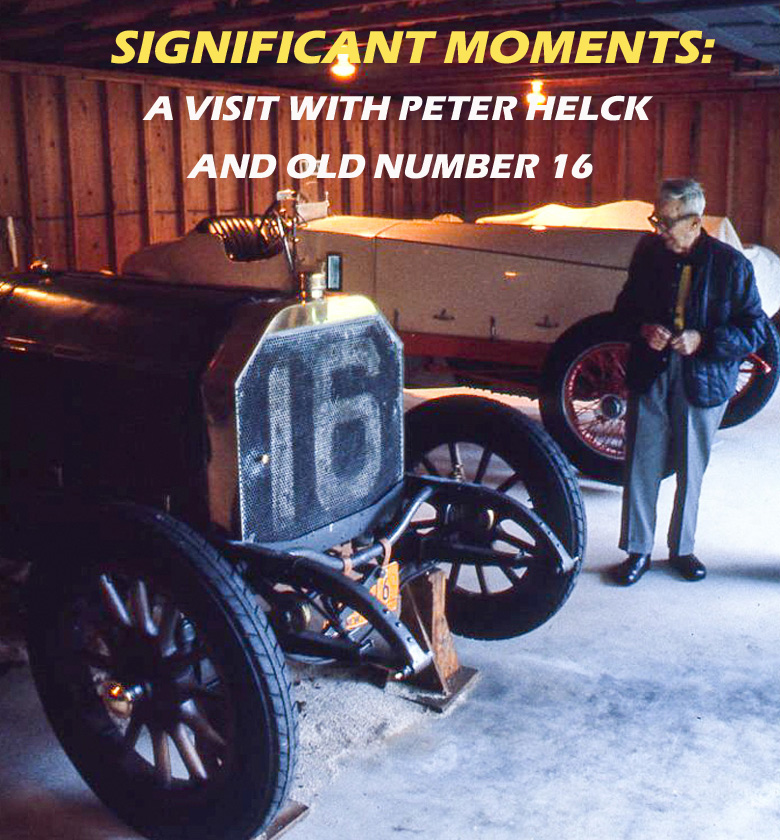By Dale LaFollette
From the VeloceToday Archives, June, 2018
On my way to the 1979 U.S. Grand Prix at Watkins Glen and I had been invited to stay for a couple of days with the 86-year-old artist Peter Helck and his wife Priscilla. Peter and I had been “pen pals” for several years but this was the first time we had actually met. I had traded one of my sculptures with Peter for one of his paintings and our mail discussions hinged on Art and turn of the century auto racing. Helck is seen in the lead photo above, walking toward Old Number 16.

The painting I received from Helck is Eddie Pullen in a Mercer leading (and winning) the 1914 Santa Monica Grand Prix. “Terrible” Teddy Tetzlaff is in the pits with his FIAT and Ralph DePalma in the “Gray Ghost” Mercedes in coming up behind.
It was truly a step back in time as their beautiful 17th century farm house was the perfect setting for a couple that remembered the first two decades of the 20th century like it was yesterday. Amongst other delights I was allowed to see Peter’s small collection of cars which included “Old Number 16”, the Locomobile with which George Robertson won the 1908 Vanderbilt Cup. It was the first time the event was won by an American car. Peter asked if I would like to sit in it; of course I would! The car was basically original, it had never been repainted and it oozed history. I had been around a ton of race cars over the years but I had never been this close to such an important one, a wonderful moment in my life.
While looking around the garage I noticed a huge piston, connecting rod and valve and asked Peter about it. He told me that many years ago a man who had worked for Locomobile in the 20s had come to the house with these items, as they were from the twin of Old Number 16.

The piston is upside down next to a one gallon paint container, roughly 6.5 inches in diameter. the Locomobile was a four cylinder with a total displacement of 976 cubic inches with 90 hp.
One day his boss told the man to take all the old race cars that had been cluttering up the shop down to the ocean and dump them, which he did. This man had saved the piston, rod and valve for no other reason than he wanted them at the time. He brought them to Peter as he thought they might be something he could use. The piston was the size of a gallon paint can which luckily is was sitting beside it for comparison.
As you imagine, the two days I spent with Peter Helck and the conversations we had are etched in my memory forever.

The sculpture I gave Helck is of Barney Oldfield’s Christie that he used in match races. This photo of Helck with the sculpture was taken by John Lamm.
For our readers who on one hand may be younger than Dale and your editor, and on the other hand may not be familiar with Peter Helck; information edited from Wiki:
He was born on 17 June 1893 in Manhattan, New York City and developed an early interest in automobiles. He attended the Vanderbilt Cup on Long Island in 1906. He studied art in New York City, where he could observe the new automobiles displayed in showrooms. His first art sale was to the Brighton Beach Motordrome, and he was soon receiving commissions from the Sheepshead Bay Speedway. Helck worked for many of the major automobile magazines, in particular The Autocar, which took him to England and to major races in France and Italy. In the 1930s Helck was commissioned by the Sinclair Oil Company to produce a large format road map which did much to build Sinclair’s reputation and to promote driving for pleasure.
In the mid-1940s he was commissioned by Esquire magazine for eight paintings depicting early motor racing.
In 1941 Helck acquired the famous Locomobile Old 16 racecar, which had won the 1908 Vanderbilt Cup, the first American-made car to win a race against international competition. Helck kept the car in its original paint. Old 16 was given to Helck’s son Jerry, who later sold it to the Henry Ford Museum.
Peter Helck died on 22 April 1988 in Boston Corner, New York.
For a contrasting look at one of the smallest diameter pistons ever to stroke a racing engine, see last week’s article on the Moto Guzzi V8, with a piston diameter of less than 2 inches.


I had a similar memorable visit with Peter Helck, sometime in the ’70s. I’d written a story for Road & Track on the Christie front-drive race cars, which Helck praised in a letter to R&T. I used that as an excuse to stop by. He gave us tea and lots of stories about the Vanderbilt Cup era. Eyewitness accounts have a magic power. It was Christmas time, so he stayed inside when I went out to the barn to see Old 16 and Rabbit, the aero-engined speed record car you see in the background. Wonderful man, great artist.
Peter Helck was way a head of his time as a collector. Old 16 is a testament to that ! I never tier of looking at it when I visit the Henry Ford Museum.
Always loved his paintings discovered in early Automobile Quarterly Magazines.
And just discover we share the same birthday of June 17, but I was born 55 years later !
Thanks much for this view of America’s great motor racing artist and “Old 16”. He had a wonderful grasp of and perspective on the monster racing cars of our first decade.
Thanks for the wonderful tribute to Peter. I was most fortunate to have been able to visit with him numerous times. My father and mother had become close friends with the Helcks and I never passed up any chance of joining them on a Sunday afternoon.
His knowledge on racing, the drivers and their machines was outstanding. But that was limited to the period prior to the 1960’s……any race car after that he felt was just an airplane without wings. During a visit I asked him about what paint scheme the Voisin Laboratoires use for the 1923 French GP thinking we would have to look it up in one of his many books. Immediately he answered that he was at that race and the Voisins were bare aluminum except for the gas tank filler covers that were blue. His talent and kindness will forever be missed.
Stan Smith, SMITHANSON ACRES, Oak Hall, Penna. USA